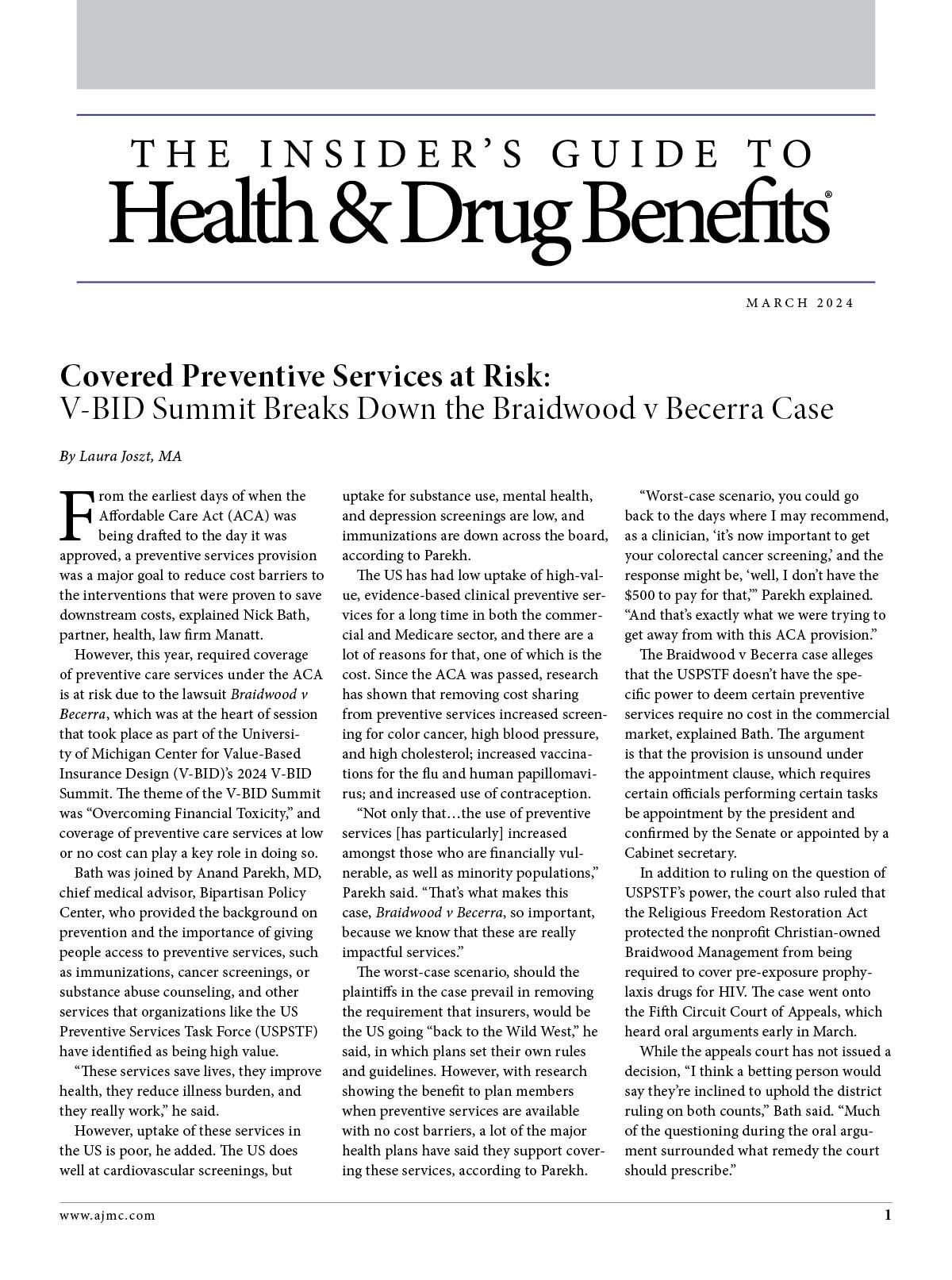- Center on Health Equity and Access
- Clinical
- Health Care Cost
- Health Care Delivery
- Insurance
- Policy
- Technology
- Value-Based Care
Reducing Low-Value Care Is Hard, but What About Just Not Paying for It?
After years of efforts to reduce low-value care, panelists at the 2024 Value-Based Insurance Design Summit proposed a new strategy: drawing a line in the sand that payers will not be on the hook for these services.
For the past 2 decades, health economists and managed care researchers—including those with the University of Michigan’s Center for Value-Based Insurance Design (V-BID) and the ABIM Foundation’s Choosing Wisely initiative—have studied the scourge of low-value care (LVC), or care that doesn’t benefit patients and often harms them. Efforts to curb the delivery of such care have yielded mixed results, so panelists at the 2024 V-BID Summit asked a different question: What if we just stopped paying for LVC?
Michael Chernew, PhD | Image Credit: Harvard Medical School

Michael E. Chernew, PhD, director at the Healthcare Markets and Regulation Lab of Harvard Medical School and co–editor in chief of The American Journal of Managed Care®, started the session with a big-picture look at 3 important questions.
- How much LVC is there? As illustrated by Choosing Wisely investigations, perhaps 10% of care is low value, but Chernew pinpointed about 2% as feasible to target.
- How do we get rid of it? Financial incentives to patients have inherent difficulties, practitioner behavior is tough to change due to ingrained cultural norms, and the successful initiatives to get a group of organizations on the same page are more the exception than the rule, Chernew said.
- Since some LVC will remain, who will pay for it? Possible answers include health care providers, by not getting reimbursed when they order or perform LVC services; health insurance carriers, who would bear the financial risk of LVC; or the end payers (employers, workers, and taxpayers), who would need to eat that cost. The last option has been the status quo, which Chernew called “problematic” in allowing LVC to persist.
A new approach is to implement performance guarantees in the contracts between carriers and payers that specify payers will not pay for LVC. There has been pushback from carriers on this idea and skepticism from those who say the potential savings would be too small, but “if we throw out all the ideas where you’re only going to save half a percent or a quarter of a percent, you’re going to have no ideas,” Chernew said. He also mentioned that these performance guarantees could be titrated to address concerns about imperfection in measurement.
Providing a real-world example of this strategy was Joshua Fangmeier, MPP, assistant director for plan strategy at Minnesota Management and Budget. His state is a large self-insured employer that has tried to use tools aligning with VBID principles to improve outcomes and save costs. A reduction in cost sharing for high-value diabetes care was successful in boosting utilization, but targeting LVC through benefit design is more challenging due to the need for nuance. To really effect change in the LVC rates, the state turned to a collaboration with its third-party administrator, which handles the day-to-day claims processing, rate negotiation, medical policy, network management, and customer service aspects of the health benefit.
When creating its request for proposal for the administrator last year, Minnesota added performance guarantees that aimed to develop accountability around LVC, focusing on 3 measures: unnecessary imaging for low-back pain, low-value vitamin D screening, and low-value testing and laboratory work prior to low-risk surgery.1 The first year of the contract will be used to inform a benchmark for future years, then the administrator’s revenue will be put at risk if the specified thresholds are not met. Fangmeier added that they are excited to see how these guarantees impact not just the specified services but also the cascades of care they spark, which can incur huge costs for both the plan and members’ out-of-pocket costs.
“When you look at just the dollars associated with just the [LVC] services, it might be half a percent or maybe 1% of total costs are likely [LVC],” he said, “but thinking through, it’s not just the service itself, but the other care that can be set off from that service.”
Chernew called this work a model of “sensible” steps that others can adapt—and cautioned that payers who don’t are leaving money on the table.
“The key point is the if you put this in a performance guarantee, these are guaranteed savings and you get a [return on investment]—depending on how aggressive you want to be—of multiples, right? This is simply, ‘We're just not going to pay for things we shouldn’t pay for.’ That’s easy money.”
Both panelists agreed that there’s no one-size-fits-all language to place in every contract, so employers interested in this approach will need to work with an employee benefits consultant who is aligned on their goals and willing to think outside of the box.
It would be much more challenging for fee-for-service Medicare to adopt performance guarantees due to federal rules and regulations, Chernew said, but the mechanisms of Medicare Advantage plans do push the risk onto carriers, and some evidence shows that accountable care organization programs’ efforts to resist paying for LVC are having the intended effect.2
Headwinds for employers may encourage them to take a harder line on LVC out of necessity, Fangmeier said, as they face the impacts of the postpandemic rebound in care, the high costs of breakthrough drugs, and the large population of members eligible for glucagon-like peptide-1 receptor agonists. These spending drivers will spur many to look for “opportunities to tackle things that do not hurt employees or their family members in terms of their financial bottom line.”
Tying together the themes of the summit in his closing remarks, Chernew said that “employers are facing this trade-off. We’re either going to charge people more out of pocket, shift costs to them, create barriers to accessing all of these needed services, or we’re going to find some other way to control spending.”
References
1. Request for proposal: plan administration for the Minnesota Advantage Health Plan. Minnesota Management and Budget. February 13, 2023. Accessed March 14, 2024. https://mn.gov/mmb-stat/segip/2023-medical-plan-admin-rfp-operational-pgs.pdf
2. Schwartz AL, Chernew ME, Landon BE, McWilliams JM. Changes in low-value services in year 1 of the Medicare Pioneer accountable care organization program. JAMA Intern Med. 2015;175(11):1815-1825. doi:10.1001/jamainternmed.2015.4525

CMS' 340B Repayment Proposal May Harm Vulnerable Hospitals, Reward Those With Higher Revenues
April 26th 2024The 340B hospitals not receiving an offsetting lump-sum payment from CMS following 2018-2022 cuts later ruled unlawful are disproportionately rural, publicly owned, and nonacademic, according to a new study.
Read More
Examining Low-Value Cancer Care Trends Amidst the COVID-19 Pandemic
April 25th 2024On this episode of Managed Care Cast, we're talking with the authors of a study published in the April 2024 issue of The American Journal of Managed Care® about their findings on the rates of low-value cancer care services throughout the COVID-19 pandemic.
Listen
Navigating Health Policy in an Election Year: Insights From Dr Dennis Scanlon
April 2nd 2024On this episode of Managed Care Cast, we're talking with Dennis Scanlon, PhD, the editor in chief of The American Journal of Accountable Care®, about prior authorization, price transparency, the impact of health policy on the upcoming election, and more.
Listen
What We’re Reading: FDA Approves UTI Antibiotic; Ozempic, Wegovy Price Investigation; US Births Fall
April 25th 2024The FDA recently approved an antibiotic for the treatment of urinary tract infections (UTIs) in women; a Senate committee recently launched an investigation into the prices of Novo Nordisk’s diabetes and weight loss drugs; US births fell last year, resuming a national slide after a previous increase during the pandemic.
Read More
The Federal Trade Commission's (FTC's) vote to ban most employers from issuing and enforcing noncompete clauses could have varying impacts on the health care workforce; federal regulators vastly under-enforced antitrust laws in the hospital sector during the last 2 decades, resulting in increased health costs; the FDA recently found genetic evidence of the H5N1 bird flu virus in pasteurized commercially purchased milk.
Read More
